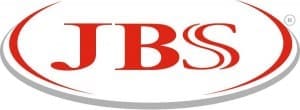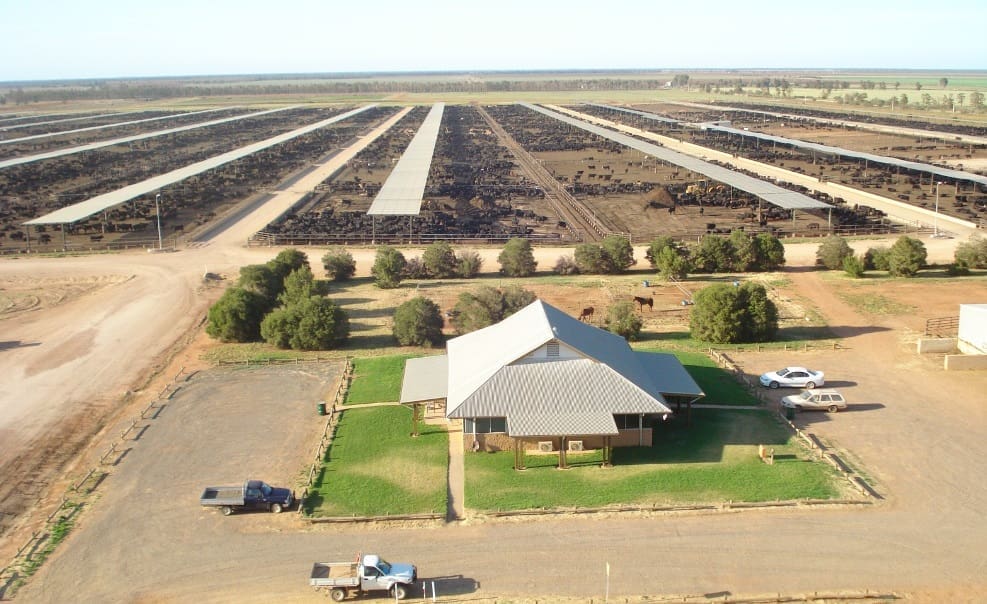Locations: Beef City, Toowoomba Qld; Prime City, Griffith, NSW; Riverina, Leeton, NSW; Caroona, Tamworth, NSW; Mungindi, Mungindi, Qld.
One time capacity: 150,000 head
2014 grainfed turnoff: 395,000 head (estimate)
2003 Top 25 position: 1 (AMH/Swift & Co)
AS Beef Central’s hugely popular Top 25 Lotfeeders feature draws to a close today, it should come as no surprise to readers to learn that JBS Australia easily retains its mantle as the largest lotfeeder in the country.
The company’s portfolio of five operational yards stretching from southern Queensland into the south of New South Wales has a one-time capacity of 150,000 head.
At the time of the previous Top 25 report back in 2003, the previous AMH business (then US-owned Swift Australia) had four yards with a total capacity of 99,000 head, and an annual cattle turnoff (2002 year, when Australian lotfeeding was in a low-cycle) of 175,000 head.
Beef Central estimates throughput from company-owned yards in 2014 at 395,000 head. That’s based on last year’s high utilisation of the yards’ one-time capacity; an average feeding duration of 135 days (excluding a handful of southern Wagyu, JBS feeds cattle from 105 to 220 days); and the fact that the Prime City yard did not begin to re-activate until March last year.
The company’s exposure to Australian lotfeeding is mirrored, also, in the US, where its Five Rivers feedlot division tops Steve Kay’s equivalent Top 30 US Lotfeeders list each year. For 2014, Steve had Five Rivers’ 11 US yards at a one-time capacity of 930,000 head, with an estimated throughput of 1.8 million cattle. It should be remembered, however, that the US beef industry is far more reliant on fed cattle than Australia.
First, a brief history lesson about how JBS Australia’s feedlot assets came together.
JBS Australia was formed in 2007 when Brazil’s Batista family bought the former Australia Meat Holdings vertically integrated processing/lotfeeding/export business, at that time owned by US-based investors, Swift & Co.
That included four large feedyards:
- Beef City, (26,500 head capacity) not far from Toowoomba on Qld’s Darling Downs
- Prime City, (licensed for 60,000, but built capacity 35,000 head) near Griffith in NSW
- Caroona (licensed for 28,000, built capacity 24,500 head) near Tamworth in northern NSW, and
- Mungindi (licensed for 22,000, built capacity12,000 head) on the Qld/NSW border.
The Beef City, Caroona and Mungindi yards came under the company’s ownership when AMH was originally formed in 1986, while it built the showcase Prime City feedlot from scratch in 1995.
In 2009, JBS purchased the Tasman Group, including Tasman’s Yambinya feedlot in southern NSW. JBS currently uses Yambinya to feed sheep only.
In 2010, JBS bought the struggling Rockdale integrated feedlot/processing business near Leeton, in southern NSW.
Rockdale was built in 1991 by Japanese investors, Itoham and Mitsubishi. Japanese business news service Nikkei at the time of its sale suggested Rockdale Beef had lost money since at least the 2008 Japanese fiscal year, with drought, a beef consumption slump in Japan, and high prices for Australian grain and feeder cattle blamed for the hardship. It was virtually empty at the time.

After its purchase, for a price reported to be about $40 million, JBS re-named the Rockdale facility Riverina, and set about re-populating the yard to its 52,000 head capacity.
Today, JBS maintains a competitive position in Australia through the operation of the only two integrated feedyard/abattoir sites in the nation. The Beef City and Riverina abattoirs are dedicated grainfed plants located next to their respective feedlots. This allows for the maximisation of animal performance and optimisation of meat quality and animal welfare outcomes.
Like all Australian feedlot businesses, JBS has experienced some tough times in grainfed operations over the years, closing its large, modern Prime City feedlot for two years in 2012 (see Beef Central’s earlier report), before re-opening in March 2014. It is now back to full capacity.
JBS was prepared to share some operational details on a company-wide basis, but not on individual feedlots.
“We have five different feedlots with a range of different feeding programs,” a spokesman said.
The company acknowledged that in parallel with the broader grainfed industry, there had been a move away from mid-to-longer days on feed in some grainfed programs over the past ten years, which had led to increased annual turnover through company yards.
Virtually 100 percent of the company’s own grainfed cattle turnoff now goes into a JBS branded beef program.
Big feeder procurement challenge
JBS is easily the largest customer in Australia for feeder cattle. One hundred percent of feeder requirements are bought out of the paddock, with virtually nil reliance on saleyards, using JBS’s network of livestock buyers across eastern Australia.
A fair percentage of feeders today are straightbred Angus, with the balance British crosses and other flatbacks, up to a content threshold of some Santa-type cattle.
A recent development is the inclusion of small numbers of Wagyu cattle on the southern feedlot inventory in the past 12 months, in a program designed to fill the needs of the company’s specialised Andrews’ Meats value-adding business, which supports its own dedicated Wagyu beef brands.
“The name JBS Australia has become synonymous with quality within the feedlot industry,” the company’s website says.
“JBS Australia has been awarded the prestigious national “Feedlot of the Year” award more than any other competitor. Our continuous high standards of performance are delivered by a team of 145 dedicated feedlot team members committed to employee safety, animal welfare and food safety,” it says.
This feature is brought to you by Lallemand Animal Nutrition.
- Click here to return to Top 25 Lotfeeders table.
- Click here to return to Top 25 Lotfeeders introductory article.





I have recently moved to Kempsey NSW and would like to know if there is someone who backgrounds or purchases cattle on your behalf in my area if not I would like to know if there was a position for myself to do so